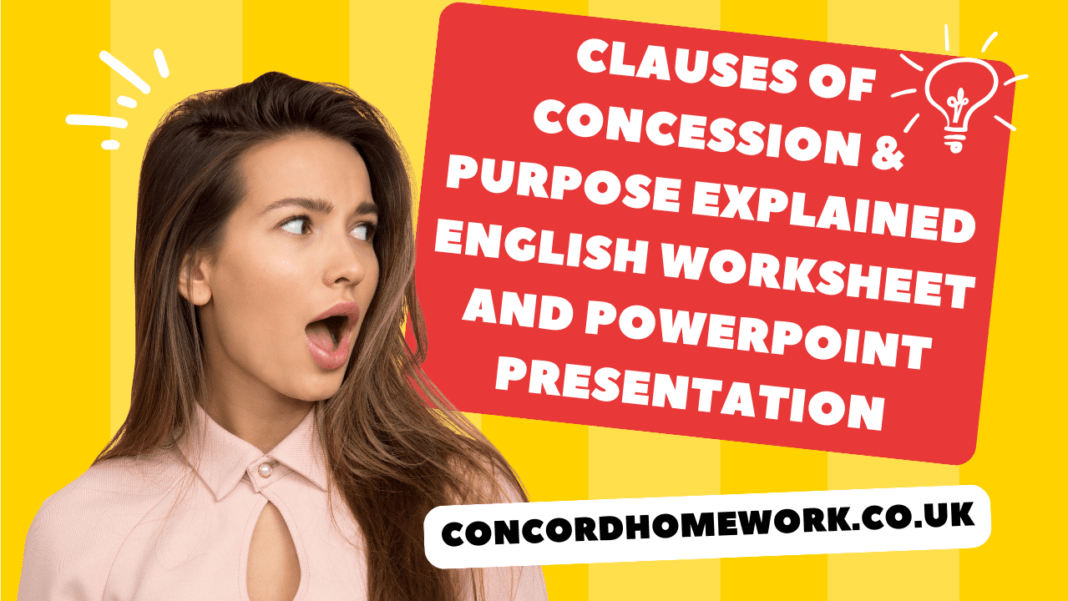In this post, you can download the PowerPoint explanation about “Clauses of Concessions & Purpose”, the PDF explanation, and the worksheet exercises with answers as well all in one place. Let me know in the comment section below if you need any specific English worksheets about Grammar, reading, listening, or writing on any related topic.
Clauses of Concession
Use:
We use Clauses of Concession to express contrast or opposition to the main clause.
Clauses of Concession:
• although / even though + subject + verb
Although / Even though he was starving, he didn’t take any of the food they offered him.
• in spite of / despite + noun / –ing form
Despite the heavy rain, it was very hot.
Despite feeling afraid, Jim went on the roller coaster.
• in spite of / despite + the fact + that-clause
He went out in spite of / despite the fact that he had a terrible headache.
Clauses of Purpose
Use:
We use Clauses of Purpose to show the purpose of an action.
Clauses of Purpose
so as (not) to / in order (not) to
so that + can / may / will /
so that + could / might / would
•so as (not) to / in order (not) to + base form
She spoke quietly in order not to / so as not to wake up the baby.
•so that + can / may / will (present / future time reference)
You should work hard now so that you can take some time off in the summer.
•so that + could / might / would (past time reference)
Henry took his car to the garage so that the mechanic could have a look at it.
All / Both / Neither / None /Either
• All is used for more than two people or things. It is used in affirmative sentences and takes a
plural verb.
Anna, Mary and Kate are going to attend a seminar. They are all very excited. / All of them are very excited.
•Both is used for two people, things, etc. It is used in affirmative sentences and takes a plural verb.
Bill and Ted are cousins. Both of them are in a team. / They are both in a team.
•Neither is used for two people, things, etc. It is used in affirmative sentences and gives them a negative meaning. It takes a singular or plural verb.
Patty and Monica want to get a cat. Neither of them has/have had a pet before.
•None is used for more than two people, things, etc. It is used in affirmative sentences and gives them a negative meaning. It takes a singular or plural verb.
All my friends love coffee. None of them likes/like tea.
•Either is used for two people, things, etc. It means one or the other (it doesn’t matter which of the two.
A: Should we order Italian or Chinese?
B: Either. I don’t mind.
both… and… / either… or… / neither… nor…
Double conjunctions (both… and…, either… or and neither… nor…) link two words or phrases in the same sentence. They are used only in affirmative sentences.
•Both… and… is used when something is true for two people, things, etc. It always takes a plural verb.
+Both my sister and my brother go to secondary school.
•Either… or… is used when something is true for one of two people, things, etc.
+Either she was too busy or she didn’t want to come.
•Neither… nor… is used when something is not true for two people, things, etc. The verb can be singular or plural.
Neither Mary nor Jim likes/like tennis.
- Download The PowerPoint Presentation about Clauses of Concession & Purpose
- Download Clauses of Concession & Purpose PDF Explanation
- Download Clauses of Concession & Purpose PDF English worksheet Exercises with Answer Key.
“Thank you for taking the time to explore this topic with us! We hope you found the information helpful and insightful. Have any thoughts, questions, or additional examples to share? We’d love to hear from you in the comments below!
Don’t forget to spread the word by sharing this blog with your friends, family, and colleagues. Together, let’s continue to learn, grow, and connect with the world around us. Happy reading and sharing!”
Follow Me On TikTok:
Follow me!????????????????
Follow me on YouTube:
Subscribe!????????????????
What topics/worksheets do you need? Let me know in the comments below!




















